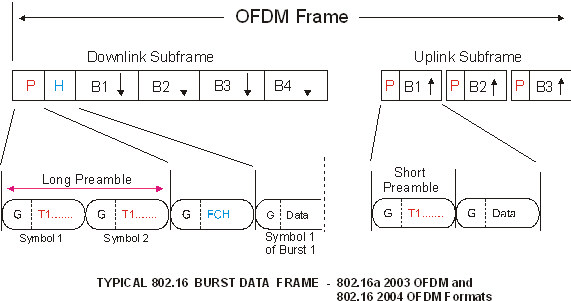802.16 OFDM Overview
Introduction
802.16 OFDM Orthogonal Frequency Division Multiplexing: OFDM employs multiple overlapping radio frequency carriers, each operating at a carefully chosen frequency that is Orthogonal to the others, to produce a transmission scheme that supports higher bit rates due to parallel channel operation. OFDM is an alternative tranmission scheme to DSSS and FHSS. signals are specified by the IEEE Institute of Electrical and Electronics Engineers. A US-based membership organisation that includes engineers, scientists, and students in electronics and related fields. The IEEE developed the 802 series wired and wireless LAN standards. Visit the IEEE at http://www.ieee.org 802.16 standards group, specializing in point-to-point broadband wireless access (BWA broadband wireless access: Wireless access in which the connections(s) capabilities are broadband.). IEEE 802.16 standard is also known as WiMAX (an acronym that stands for Worldwide Interoperability for Microwave Access), a standards-based wireless technology that provides high-throughput broadband connections over long distances.
WiMAX is a wireless metropolitan area networks (MAN) technology that will connect 802.11(WiFi) hotspots to the Internet and provide a wireless extension to cable and DSL for last mile (last km) broadband access. 802.16 provides up to 50 km (31 miles) of linear service area range and allows users connectivity without a direct line of sight to a base station. The technology also provides shared data rates up to 75 Mbit/s. IEEE 802.16 standards are concerned with the air interface between a subscriber's transceiver station and a base transceiver station.
Signal Characteristics
The 802.16 OFDM option provides modulation analysis for IEEE 802.16a-2003 OFDM and IEEE 802.16-2004 OFDM standard signals. These are digitally modulated signals that utilize the OFDM (Orthogonal Frequency Division Multiplexing) modulation format. OFDM extends the concept of single carrier modulation by using multiple subcarriers within the same single channel. The total data rate to be sent in the channel is divided between the various subcarriers.
The basic OFDM symbol is based on a 256 point FFT Fast Fourier Transform: A mathematical operation performed on a time-domain signal to yield the individual spectral components that constitute the signal. See Spectrum.; however, in 802.16 only 200 of the subcarrieres are actually used. The outermost subcarriers are set aside (unused) to allow for guard bands and natural decay of the subcarrier energy. Also, the center frequency is not used because it is susceptible to RF Radio Frequency: A generic term for radio-based technologies, operating between the Low Frequency range (30k Hz) and the Extra High Frequency range (300 GHz). carrier feed through. Of these 200 subcarriers, 192 are used for data and eight are used as pilots. The pilot carriers are always BPSK Binary phase shift keying - A type of phase modulation using 2 distinct carrier phases to signal ones and zeros. modulated and the data carriers are BPSK, QPSK Quadrature phase shift keying, 16QAM or 64QAM.
An 802.16 OFDM frame consists of a downlink subframe and uplink subframes. In TDD Time Division Duplex: A duplexing technique dividing a radio channel in time to allow downlink operation during part of the frame period and uplink operation in the remainder of the frame period. mode, the downlink and uplink subframes use the same carrier frequency causing downlink and uplink to alternate in time. In FDD Frequency Division Duplex: A duplex scheme in which uplink and downlink transmissions use different frequencies but are typically simultaneous. mode, the downlink and uplink subframes use different carrier frequencies so that both subframes may transmit in parallel. Also in FDD mode, it is possible for the downlink subframe to last the entire length of the frame. In this case, there may be no "off" time between one downlink pulse and the next causing the signal to look like it is continuously on.

A downlink subframe consists of a single pulse which starts with a long (2-symbol) preamble. The preamble is used for channel equalization and synchronization. Optionally, the bursts within the downlink subframe can start with a short (1-symbol) preamble symbol. The preamble is followed by the Frame Control Header (FCH) which is always 1 symbol long. The FCH contains a message describing characteristics of the downlink subframe that help decode the remainder of the downlink bursts. The FCH data field is transmitted using BPSK and encodes the length and data modulation format of the subsequent bursts.
The downlink pulse can contain multiple bursts. The number of bursts can vary from pulse to pulse. Each burst can have a different modulation type but within each burst the modulation type is constant. The bursts can have one or more Data symbols. Each symbol in a burst contains 192 carriers of data and 8 pilot carriers. The symbols consist of a guard-band (also called guard interval or cyclic prefix) and a data region. The guard-band is merely a repeated segment of the end of the data region that has been replicated and prepended to the beginning of the data region. The guard-band is necessary to prevent multi-path channel interference.
The magnitude and phase of a subcarrier indicates the symbol-value being transmitted. The magnitude and phase can vary for each subcarrier from symbol-time to symbol-time. Therefore, 200 symbols are transmitted each symbol-time. The total number of symbols transmitted during a pulse depends on the number of symbol-times within that pulse.
An uplink subframe consists of one or more pulses, each of which starts with a short (1-symbol) preamble. After the short preamble, there is a single burst consisting of multiple DATA symbols all using the same data modulation format. An uplink pulse can optionally be a "subchannel" pulse, which means it uses only a subset of the full 200 subcarriers. There are 31 different possible subchannels that can be used. An uplink pulse can optionally include embedded midamble symbols, each of which is identical to the short (1-symbol) preamble that was found at the start of the uplink pulse.
See Also
IEEE 802.16 OFDM Demod Properties Dialog Box
